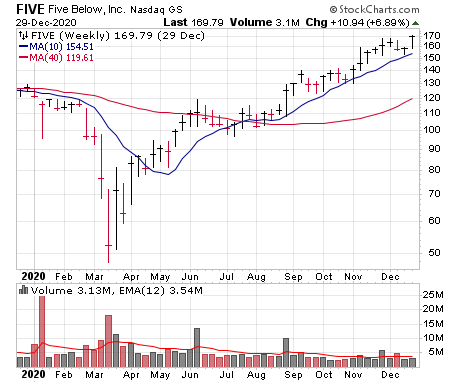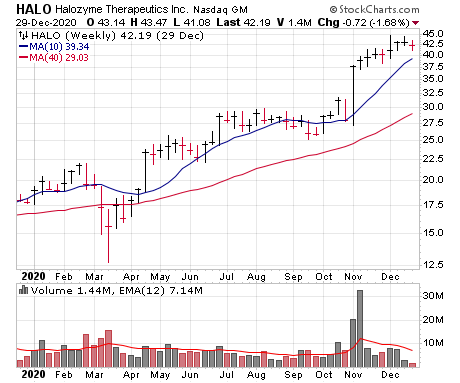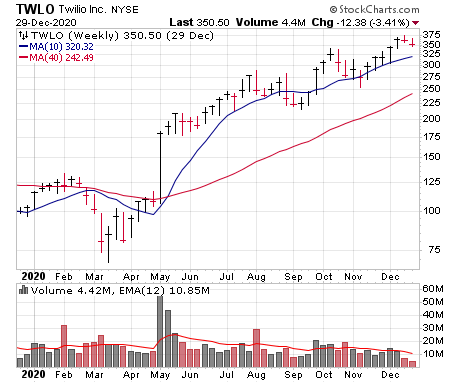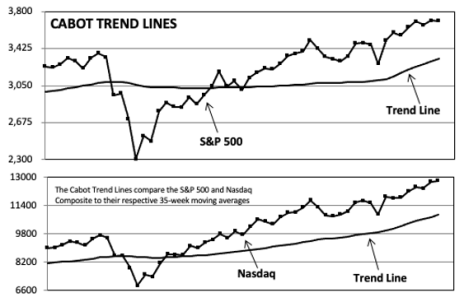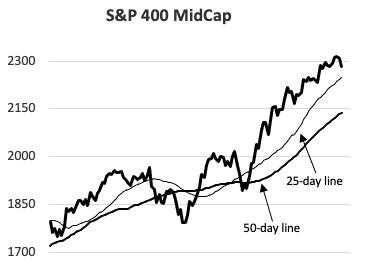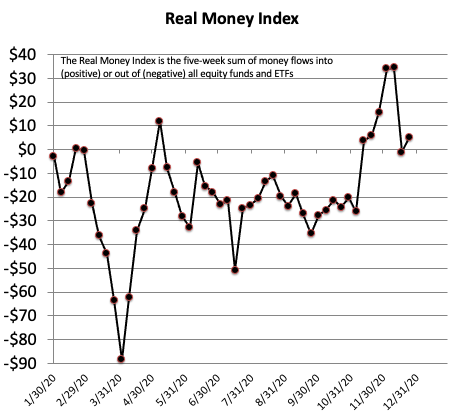It’s been a great year for growth stocks, and we’re glad to have easily outperformed the major indexes, adding to our longer-term track record. Whatever the exact numbers, we hope you enjoyed a prosperous 2020, and have a great and healthy New Year.
That said, we’re always looking ahead. Big picture, we remain bullish, but growth stocks have hit a bit of a pothole this week, which wasn’t totally unexpected. We’re not reacting to the action yet, though we’re also comfortable holding our 19% cash position and see what comes as the calendar flips.
Cabot Growth Investor 1462
[premium_html_toc post_id="222615"]
Happy New Year
It’s been a long, strange 12 months, but it’s also been a very prosperous period, at least for growth investors—with one day left in the year, the Model Portfolio is up around 60%, easily besting most major indexes. Happily, that builds on our track record for the past few years (up 160% over the past four years vs. half that for the S&P 500) and longer term (topping the S&P by 4.6% annually, not including dividends, since I took over 14 years ago). Whatever the exact numbers, we hope you were solidly in the black in 2020 as well.
But the market is all about the future, so while we’ll enjoy a couple of bourbons to celebrate tomorrow evening, the focus is on what comes next. Interestingly, given 2020’s shenanigans, we shouldn’t be surprised that it’s tossing us one more curveball this week: We’ve seen another round of rotation sending extended growth stocks lower while the major indexes and the broad market mostly hang tough.
Of course, we’ve been half-expecting some air pockets recently due to the big run in so many stocks (some are up 25% to 50% just since early November) and the elevated sentiment, so we’re not overreacting. Indeed, we actually see many tempting pullback entry points possibly developing … if growth stocks settle down and find support in the days ahead. If they don’t, it’s possible a deeper retrenchment has arrived.
Because of that uncertainty—and the fact that Januarys are often tricky, especially after big up years (see our writeup later in this issue for more on that)—we’re content to ride into 2021 in our current stance, holding around 19% in cash, and are willing to trim if the sellers really dig in their heels. As usual, we’ll just go where the market and growth stocks take us.
At heart, though, we’re still optimistic when looking out over many months. While the initial shock and horror of the pandemic has worn off, many are quick to bail out after a bad day or two, a sign that skittishness remains in play. And, chart-wise, we remain very encouraged by the swath of longer-term (one-year or longer) breakouts seen in recent weeks, not to mention the mini-blastoff indicators that flashed after the election in early November, both of which bode well for the New Year.
What To Do Now
Thus, the game plan from here on is pretty straightforward—should growth stocks rest and find some support around here, we’ll look to do some new buying (either filling out current positions or adding new ones). Conversely, if the sellers make a stand in the New Year, we could trim and raise a little cash. Right now, though, we think our positioning is about where it should be.
Model Portfolio Update
2020 has been a wild year, and it’s given us one more grey hair before the calendar flips, with a rotation out of some hot growth stocks this week and into some big-cap names and other cyclical areas. As always, we’re certainly not whistling past the graveyard, but some potholes weren’t unexpected after the recent surges in many stocks, so we’re content to watch and wait to see how it goes after the calendar flips.
For the Model Portfolio, we’ve been steadily stepping our way into a heavier-invested position during the past few weeks but given the lack of good entry points and this week’s hiccup, we’re standing pat tonight, holding our 19% cash position. As has been the case with prior sharp one- or two-day rotations, the key will be what happens from here—further modest weakness followed by a show of support could reveal a few high-odds entry points in leading stocks, but if not, we may pare back on names we don’t have much profit in (or take partial profits in a winner or two). Tonight, though, we have no changes.
Current Recommendations
| Stock | No. of Shares | Portfolio Weightings | Price Bought | Date Bought | Price on 12/30/20 | Profit | Rating |
| CrowdStrike | 567 | 6% | 175 | 12/11/20 | 210 | 20% | Buy a Half |
| Five Below (FIVE) | 1277 | 10% | 138 | 9/18/20 | 173 | 25% | Buy |
| Halozyme (HALO) | 2339 | 5% | 41 | 11/27/20 | 43 | 5% | Buy a Half |
| Novocure (NVCR) | 1,335 | 11% | 142 | 11/6/20 | 174 | 23% | Buy |
| Pinterest (PINS) | 2962 | 10% | 40 | 9/18/20 | 67 | 69% | Buy |
| ProShares Ultra S&P 500 (SSO) | 1,741 | 8% | 60 | 5/29/20 | 90 | 51% | Buy |
| Roku (ROKU) | 901 | 14% | 205 | 8/28/20 | 339 | 65% | Buy |
| Twilio (TWLO) | 553 | 9% | 174 | 5/8/20 | 350 | 101% | Buy |
| Uber (UBER) | 3,656 | 9% | 52 | 11/20/20 | 53 | 3% | Buy |
| CASH | $382,540 | 19% |
CrowdStrike (CRWD)—CRWD has pulled in this week, but it’s still off to a good start for us, thanks to a little luck—the headline-grabbing SolarWinds hack a couple of weeks ago boosted perception of all cybersecurity names, and it looks like big investors see CrowdStrike as the biggest beneficiary. Indeed, SolarWinds actually deployed the company’s platform to protect its endpoint devices in the wake of the breach, and it’s thought that the same hackers tried to breach CrowdStrike’s systems (through a reseller) but failed! Business was already strong, of course, and the thought is that this hack will only up the need for the firm’s offerings going forward. As for the stock, we think the three straight big-volume up weeks out of the October/November rest is a sign CRWD wants to go higher after it shakes out some weak hands. We’re not in a rush to fill out our position right here—we’d like to see the stock find some support and calm down a bit—but if you don’t own any, you could buy a half-sized position around here or on further dips. BUY A HALF.
Five Below (FIVE)—FIVE continues to get tossed around on a day-to-day basis based on what sectors and themes are in favor, but overall, it remains in a firm uptrend; indeed, the recent correction nearly touched the 10-week line, which brought in some big-volume buying and pushed shares to new highs this week! Fundamentally, one thing that has Wall Street intrigued is the firm’s experimentation with higher pricing: For years, everything was $5 or less at the store, but now the company is offering a set of higher-quality items (mostly tech stuff like wireless keyboards, gaming headsets and wireless speakers) for up to $10, which has the potential to boost Five Below’s addressable market and possibly lead to higher margins, too. Analysts still see next year’s bottom line around $4 per share (nearly double this year’s tally), and even that could prove conservative. Back to the stock, a break of the 50-day line (150 or so) could have us going to Hold, but right here, FIVE looks very solid. BUY.
Halozyme (HALO)—Along with CrowdStrike, HALO is our other remaining half position, which we’d like to fill out if this week’s dip (both in growth stocks, and in this stock in particular) finds support. Fundamentally, the story keeps improving, with the E.U. approving a drug by Roche that uses Halozyme’s Enhanze technology; that marks the firm’s fourth drug approval (two in the U.S., two in Europe) this year. Nothing has changed with our thoughts here—Halozyme seems on the cusp of booming sales and earnings (the firm is actually buying back a few shares, a rarity for a young medical outfit), and the stock just got going from a multi-year base a couple of months ago. We could buy more if HALO remains in good shape early in the New Year, but for now, we’ll sit tight. BUY A HALF.
Novocure (NVCR)—NVCR hiccupped with everything else this week before snapping back nicely today; the 25-day line is down near 154 and rising, so the stock has earned the right to futz around for a bit if it wants. Nothing has changed with the overall story, but one thing to keep an eye on going forward is JP Morgan’s healthcare conference, as Novocure will present the morning of January 12—it’s possible the firm will release some trial tidbits or updates, which could move the stock. Barring something major changing, though, 2021 is set up as a year of solid sales (up 20%-plus) and earnings (nearly doubling) growth, with readouts (full data or interim analysis) from five different clinical trials involving its Optune system. We’ll stay on Buy, but we favor either starting small up here or aiming to enter on dips of a few points. BUY.
Pinterest (PINS)—We’ve been writing that PINS has lost some upward momentum of late, and that’s led to some downside this week, with the stock cracking its 25-day line for the first time since September. Even so, we’re fine with the action—we’ll see how it goes, but a trip to the 50-day line (now near 64) should offer a solid entry point, especially if the market weakens a bit from here. That said, we’re not complacent after a big run, either (if you have a loss or little profit, a stop in the low 60s makes sense), but we have a good-sized gain, have already booked partial profits and think the stock has lots of upside down the road. (Also, going along with our lesson later in this issue, one thing we learned this year is to try to give early-stage names that we’ve already booked some profits in plenty of rope to resume their advance.) Long story short, the near-term could provide some more rockiness, but we’re holding our stake, and if you don’t own any, you can grab shares here or on further dips. BUY.
ProShares Ultra S&P 500 Fund (SSO)—The S&P 500 (and, hence, SSO) actually hesitated for three weeks after the start of December, but it’s pushed decently higher since last Monday’s shakeout (on news of the new strain of the virus in Britain) to the 25-day line. As we write later in the issue, big up years (for the Nasdaq anyway) often do lead to some sort of good-sized pullback starting in January; that’s not a sure thing, but it goes along with other evidence that the risk of a trickier environment is rising. However, it’s also very common that the year following a big up year leads to above-average gains, too, and we like the steady-as-she-goes advance (no blowoff signs) since the post-election kickoff. All told, we remain bullish, and think SSO should head higher in the intermediate term. BUY.
Roku (ROKU)—ROKU has finally let a little air out of its balloon, but the dip has been very reasonable so far, giving up a max of 30 points after a 120-point moonshot since mid-November. There’s no doubt that a lot of good news has been released of late, including the latest deal with HBO earlier this month (HBO Max went live for subscribers on Roku’s platform on December 17), so any disappointment (good-but-not-amazing holiday sign ups, etc.) could bring out the sellers. Thus, we’re still open to taking some partial profits in the days or weeks ahead, but really, the action to this point has been pristine, and because the stock should still be early in its overall run, we’re not rushing it—big picture, Roku reminds us a lot of AOL back in the late 1990s, which was (for many years anyway) the biggest way for individuals to get online, and Roku is in a similar position in terms of streaming and connected TV. We’re open to anything, but given the evidence today, we’re holding what we own, and think further dips would be buyable. BUY.
Twilio (TWLO)—Breakouts that come a couple of months after the market gets going in a new intermediate-term advance tend to be choppier, and that’s what we’re seeing with TWLO, which has sputtered a bit this week along with most growth stocks. It’s always possible the stock’s big ups and downs from recent months could continue going forward (a drop back into the low 300s could have us retreating from our Buy rating), but we still think the evidence points toward August through mid-December being a normal rest and now the next upleg has begun. At day’s end, we think the stock represents rare merchandise—there aren’t many well-traded stocks with rapid growth and a story and products that position it at the heart of the digital revolution. BUY.
Uber (UBER)—UBER looked a bit tenuous a couple of weeks ago, but after initially dipping below 49 on the new virus strain news, it’s found good support and, while it may need a little longer to rest (the 50-day line is near 47 and rising), we think the next major move is up. While there are always potential potholes in any story, it appears little is standing the way of a huge next few quarters for Uber: The combination of the vaccines and yet another stimulus package should goose the economy next year (helping the Rides segment), while the acquisition of Postmates and secular trends should keep the Delivery business humming. Analysts see cash flow getting to breakeven next year while revenues soar 42%, and both could prove conservative if worldwide economies really take off. If you don’t own any, you can buy UBER here. BUY.
Watch List
- Bill.com (BILL 137): BILL is a name we could pull the trigger on if it and growth stocks stabilize, as the recent dip looks like a classic early-stage pullback setup.
- Farfetch (FTCH 65): FTCH has the look and smell of a new leader—it operates the largest digital luxury marketplace in the world, and the stock has been under tremendous accumulation. See more below.
- Floor & Décor (FND 94): FND is another stock that’s had a big recent move (80 to 100 in round numbers), so the recent dip looks like a normal shake-the-tree event.
- Spotify (SPOT 319): SPOT is hacking around just on top of its prior base. It looks fine, though we wouldn’t say it’s on the top of our watch list due to the growth profile (good not great) and because the RP line isn’t inspiring.
Other Stocks of Interest
Inari Medical (NARI 87)—Inari Medical’s story revolves around thrombectomies, which is a procedure to remove a blood clot but where most devices have been designed for arteries. However, many dangerous clots occur deep in veins or in pulmonary embolisms (clot breaks loose and travels into the lung), and those veins have different blood flows, larger/harder clots and different-sized vessels. (Both conditions can lead to serious repercussions.) Historically, doctors have used repurposed arterial devices for these venous procedures along with clot-busting drugs, which are ineffective, high risk and expensive. Inari has a better way, with a couple of specialized products (ClotTriever and FlowTriever) that are designed for these venous clots, eliminate the need for drugs and have been shown both in trials (recent results showed 0.4% death rate vs. 6.1% with normal treatments; re-admission rate of 6.7% vs 25% in general) and in the real world (3,700 procedures in Q3 alone, up 184% from a year ago). Hospitals love it, too, as they’re able to crank out far more profit due to fewer complications, shorter stays and no infrastructure needed (disposable products). As Inari has expanded its sales force and as word has spread, growth has gone bananas, with triple-digit revenue growth (152% and 172% the past two quarters) and a bottom line that’s been in the black four of the past five quarters. NARI is new and the valuation is definitely up there ($4 billion market cap; revenue run rate of $155 million!), but some smart funds have already taken a position, volume is expanding steadily and the stock itself has set up a decent-looking IPO base. Volatility is very high, but it’s an intriguing story.
Farfetch (FTCH 65)—We’re not a fan of chasing a bunch of extended stocks, especially after a big run in the market like now. But we do like to keep an eye on some fresh leaders even if they are sticking straight up in the air, thinking that any sharp pullback should provide a good opportunity to enter. One we’re keeping an eye on is Farfetch, which we’ve written about before and whose stock is under incredible accumulation for good reason: The company operates the leading global platform for luxury fashion, an industry that’s exploding not just because of Covid but also as brands put more emphasis on broader distribution and less on brand and marketing control. (Luxury purchases made online made up 12% of the industry’s sales last year, but that should grow to 30% by 2025.) Business has been booming for a while and has remained red hot this year (Q3 gross merchandise value rose 62% while sales were up 71%), with big investors thinking more is on the way—Farfetch’s partnership with Alibaba and Richemont (owner of Cartier and many other luxury brands) brought in $1.1 billion and accelerated its move into China, which by 2025 is expected to make up nearly half of the global luxury market! Farfetch is targeting EBITDA profitability next year as revenues grow 33%, but we think that will prove very conservative. The stock has been a moonshot, but the power has been impressive, with four straight weeks of out-of-this-world weekly volume after its breakout in early November. As we wrote above, FTCH is extended here, but the next pullback (possibly to the 10-week line, which is nearing 53 and rising quickly) could provide an entry point.
SiteOne Landscape (SITE 158)—We keep to certain liquidity requirements in the Model Portfolio (we require more than $50 million per day, and many of our winners trade north of $150 million daily), but that doesn’t mean there aren’t some thin traders that are tempting. SiteOne Landscape is one of those ($37 million of trading volume), with a simple, reliable growth story that’s attracted a good number of owners (545 own shares, up from 428 a year ago). The company is by far the largest (four times the size of its nearest competitor) wholesale distributor of landscape supplies, with more than 550 branches and three distribution centers in the U.S. It’s a big ($20 billion), slow-growing market, but it’s also very fragmented (the company has just 12% market share), which is the main attraction here—SiteOne is consolidating the industry, using its size to swallow up numerous smaller fish and integrate them into its national operation. It’s purchased 53 outfits since 2014, including nine in 2020 that have brought 26 branches and annual revenues of more than $154 million onboard, and with thousands of little local distributors across the U.S. (not to mention a clean balance sheet with lots of liquidity), there’s no reason the spending spree won’t continue for years to come. Despite the early-year virus hiccups, 2020 has been a good year for the company; Q3 saw sales up 15% (including 11% organic growth) while EBITDA (a measure of cash flow) for the year as a whole will likely rise about 16%, and analysts see more of the same in 2021 and beyond. As for the stock, we wrote SITE up four months ago on this page, but shares mostly chopped sideways through November. Now, though, it’s begun to stretch its legs, gliding to new all-time price and RP highs. We’re probably not going there in the Model Portfolio because of the light trading volume, but SITE certainly has the look and feel of a winner.
Lessons Learned
It’s our last issue of the year, which is where we like to review some of our highlights and lowlights of the year, and relay any lessons learned (or re-learned). Obviously, this has been a great year for growth stocks and the Model Portfolio (one of the top handful of highest returning years ever, and the highest since I took over 14 years ago), but the fact is that you never want to get too high or too low—when you have a rough year, there’s no reason you can’t bounce back, and when you have a good year, there’s still room for improvement.
We haven’t finished our review of this year’s trades, but here are a couple of straightforward lessons we’ll be emphasizing as we roll into 2021:
Lesson #1: Believe what you see, and not what you believe
It’s easy to say “I’m simply going to follow the market’s action and ignore my own judgment,” but it’s hard to implement it when the bad news is everywhere. 2020 provided a great example of that, as economic statistics were setting worst-ever records for GDP, unemployment, small business deaths and more while the Nasdaq and leading growth stocks were embarking on one of their strongest runs seen during the past 20 years.
As always, the key is realizing that the market is not trading on today’s or tomorrow’s earnings, interest rates or news headlines—instead the market is looking ahead three to nine months (generally speaking) and discounting what it thinks the world will look like then. In fact, this is why trend following works: It takes time for most investors to come around to what reality will be, and as more do change their view, prices work higher (or lower) along the trend.
Whatever happens in 2021 and beyond, though, you’ll be better off believing what you see—as Jesse Livermore said, markets are never wrong, but opinions often are.
Lesson #2: If you’ve taken partial profits, don’t get caught “in the middle”
As mentioned above, there’s room for improvement even in a good year, and one area we definitely slipped up this year was not giving a couple of stocks enough room in the summer even after we had booked partial profits. One thing we try to avoid is being caught “in the middle”—i.e., not selling soon after the high and not having the patience to ride through what is a reasonable correction (sometimes 25% to 30%) after a huge run, with the result that we end up getting shaken out after a big drop, near a stock’s correction lows.
That’s exactly what happened to us with Cloudflare (NET). On the surface, it was a solid trade for us—NET was one of the first stocks we bought after the March panic low (bought in at 26 on April 20; filled out our position at 28.4 in early June), and it motored into the mid 40s by August. Then, as growth stocks began to struggle, we pruned one-third of our shares in early August, with the intent of giving the rest room to maneuver.
But we didn’t follow that plan! When the market took a tumble a month later, NET broke its 50-day line and we dumped the rest of it—in all, the profit was north of 30%, which is better than nothing, but the stock has more than doubled since that sale. By itself, NET would have added another 10 percentage points to the Model Portfolio’s performance if we held on! Ouch!
To be sure, this has been a strong bull market year, which skews the results; if the market turned choppy, maybe NET wouldn’t have had such a run. But the point is that NET was early-stage (recent IPO, etc.) and there were other options besides selling wholesale (maybe another round of partial profits?), especially given our still-healthy profit.
Of course, there will be a lot more than two lessons learned from this (or any year), and if we come across any major ones we’ll be sure to share them. But after our initial run through our trades these two definitely stood out.
What Happens After a Huge Up Year?
2020 has been a great year, but we’re always focused on the future, so one question that’s come up is what happens after a big bullish year? The answer: Generally good things for the next year as a whole, though early-year volatility is a good bet. That fits in with what we’ve been writing for the past few weeks.
Since 1975, there have been 10 other years where the Nasdaq has returned at least 30%, and as it turns out, strength tends to beget strength—eight of the 10 following years sported gains, with an average return of more than 14%. In other words, the current bull market should have plenty of upside left down the road.
However, the early-year action is a lot more mixed. While the returns the following January weren’t bad (up 1.4%), four of the Januarys that came on the heels of these big up years sported losses, and almost all of them saw the sellers step up at some point: On average, a 7% correction in the Nasdaq (some a lot more intense) got underway sometime in January.
We wouldn’t use this simple study as any kind of exact roadmap, but the fact is January is often tricky no matter what due to profit taking and repositioning by big funds, and that pattern seems to be intensified after a big up year. It’s something to keep in mind.
Cabot Market Timing Indicators
Staying in gear with the evidence (mostly the trends of the major indexes and action of leading growth stocks) has helped us in a big way this year, and on that front, there’s plenty to like looking out over the next few months. That said, the recent wobble in growth stocks has us watching and waiting for the moment.
Cabot Trend Lines: Bullish
Our Cabot Trend Lines have remained clearly bullish since June despite a couple of tough rotations and lots of crosscurrents. And they remain in great shape today—last week, the S&P (by nearly 12%) and Nasdaq (by almost 18%!) closed the week well above their respective 35-week moving averages, a sure sign that the longer-term trend remains up and that the bull market is intact.
Cabot Tides: Bullish
The Cabot Tides are also looking good, remaining on their post-election Buy signal. It’s true that a couple of indexes have stalled out a bit in December, but all five (including the S&P 400 MidCap, shown here) are still nicely above their lower (50-day) moving averages. With both the intermediate- and longer-term trends pointed up, it’s best to keep your optimist’s hat on.
Cabot Real Money Index: Neutral
Year-end often sees some crazy ins and outs in terms of money flows, and this year has been no different, with a big outflow two weeks ago followed by an equally big inflow last week. Net-net, our Real Money Index is back in neutral territory, which is good, but we’ll be interested to see what comes as the calendar flips.
Charts courtesy of StockCharts.com
The next Cabot Growth Investor issue will be published on January 14, 2021.
Cabot Wealth Network
Publishing independent investment advice since 1970.
President & CEO: Ed Coburn
Chairman & Chief Investment Strategist: Timothy Lutts
176 North Street, PO Box 2049, Salem, MA 01970 USA
800-326-8826 | support@cabotwealth.com | CabotWealth.com
Copyright © 2020. All rights reserved. Copying or electronic transmission of this information is a violation of copyright law. For the protection of our subscribers, copyright violations will result in immediate termination of all subscriptions without refund. No Conflicts: Cabot Wealth Network exists to serve you, our readers. We derive 100% of our revenue, or close to it, from selling subscriptions to its publications. Neither Cabot Wealth Network nor our employees are compensated in any way by the companies whose stocks we recommend or providers of associated financial services. Disclaimer: Sources of information are believed to be reliable but they are not guaranteed to be complete or error-free. Recommendations, opinions or suggestions are given with the understanding that subscribers acting on information assume all risks involved. Buy/Sell Recommendations: All recommendations are made in regular issues or email alerts or updates and posted on the private subscriber web page. Performance: The performance of this portfolio is determined using the midpoint of the high and low on the day following the recommendation. Cabot’s policy is to sell any stock that shows a loss of 20% in a bull market or 15% in a bear market from the original purchase price, calculated using the current closing price. Subscribers should apply loss limits based on their own personal purchase prices.

